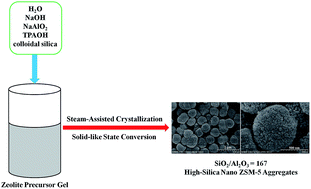Direct synthesis of high-silica nano ZSM-5 aggregates with controllable mesoporosity and enhanced catalytic properties†
Abstract
High-silica nano-sized ZSM-5 aggregates have been rapidly synthesized from a low-templated dry gel by solid-like state and a steam-assisted conversion; the crystallization of ZSM-5 aggregates is well induced within 48 h at a TPAOH/SiO2 of 0.05. The influence of synthesis conditions such as NaOH/SiO2 ratio on the final products was investigated. The mesopore distribution can be facilely controlled by adjusting the size of primary particles via modulating the alkalinity of the synthesis gel. The ZSM-5 aggregates obtained by varying Na2O/SiO2 molar ratios from 0.05 to 0.13 are denoted as NA-X (X = 1–4). The NA-X samples are characterized by techniques including XRD, SEM, TEM, N2 adsorption–desorption, NH3-TPD and Py-IR. SEM revealed that the obtained NA-X were ellipsoidal spheres that consisted of nano-sized crystallites with 20–70 nm. It is found that NA-2 exhibits a mesopore distribution around 12 nm and possesses the largest amount of external acid sites, which lead to the remarkably improved catalytic performance in methanol to propylene (MTP) reaction. A possible growth mechanism of self-assembled NA-X zeolites directed by tetrapropylammonium hydroxide (TPAOH) is proposed. The crystallization process indicated that the size of raw materials gradually decreased, formed nano-sized particles and the stacking of the resulting small zeolite crystals will form NA-X zeolites with prolonged time. Compared with the conventional hydrothermal route, the solid-like state and steam-assisted conversion not only significantly shortened the crystallization time, but also greatly reduced the emissions of waste liquids. In addition, for the MTP reaction, the NA-X zeolites obtained by this method showed much better catalytic performance, propylene selectivity and longer lifetime to endure coke deposition than the sample obtained by the hydrothermal route.


 Please wait while we load your content...
Please wait while we load your content...